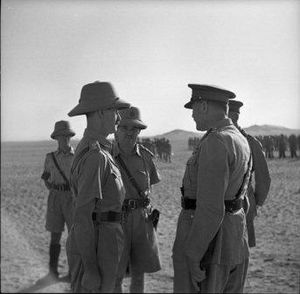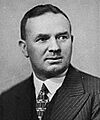James Hargest facts for kids
Quick facts for kids
James Hargest
|
|
|---|---|
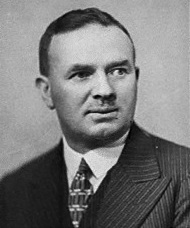
Hargest in 1935
|
|
| Born | 4 September 1891 Gore, New Zealand |
| Died | 12 August 1944 (aged 52) Normandy, France |
| Allegiance | New Zealand |
| Service/ |
New Zealand Military Forces |
| Rank | Brigadier |
| Service number | 31156 |
| Commands held | 2nd Battalion, Otago Infantry Regiment 5th Infantry Brigade |
| Battles/wars | First World War |
| Awards | Commander of the Order of the British Empire Distinguished Service Order & Two Bars Military Cross Efficiency Decoration Mentioned in despatches Legion of Honour (France) War Cross (Greece) |
James Hargest was a brave New Zealand soldier and politician. He served as an officer in both the First World War and the Second World War. He was also a Member of New Zealand's Parliament from 1931 to 1944. He represented the Invercargill and later the Awarua areas.
Born in Gore in 1891, James Hargest was a farmer. When the First World War began in 1914, he joined the army. He became an officer and fought in the Gallipoli campaign in 1915. He was badly hurt there. After getting better, he returned to fight on the Western Front. He led an infantry battalion and earned several awards for his strong leadership.
After the war, he went back to farming in New Zealand. In 1931, Hargest became a Member of Parliament for Invercargill. He was a strong supporter of the National Party, which formed in 1936. He later represented the Awarua area.
When the Second World War started in 1939, Hargest wanted to fight again. Even though he was first turned down for health reasons, he was accepted after the acting Prime Minister helped him. He became the commander of the 5th Infantry Brigade. He led his brigade in the Battle of Greece and the Battle of Crete in 1941. During the Battle of Crete, his decisions about positioning his troops were criticised.
Later, in North Africa, he was captured by German forces during Operation Crusader in November 1941. He was held in a prisoner of war camp in Italy. But he managed to escape! He made his way back to England in late 1943. He received another award for his amazing escape. In June 1944, he went to Normandy as an observer for the Normandy landings. He was sadly killed by artillery fire just over two months later.
Contents
Early Life and Army Start
James Hargest was born on 4 September 1891 in Gore, a small town in Southland, New Zealand. His parents, James and Mary Hargest, came from Wales. His father was a farmer. James was the fourth of nine children. He went to school in Gore and Mandeville. After school, he worked with his father on the farm. In 1911, he joined the Territorial Force, which was like a part-time army. By 1914, he was a sergeant.
Fighting in the First World War
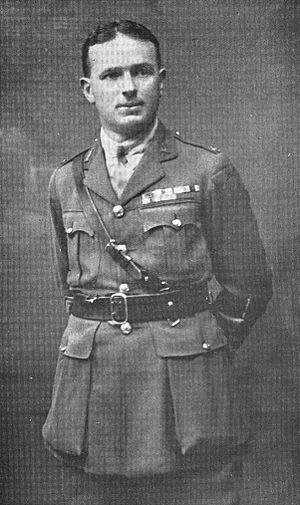
When the First World War began in August 1914, Hargest joined the New Zealand Expeditionary Force (NZEF). He became a second lieutenant in the Otago Mounted Rifles. He fought in the Gallipoli Campaign in Turkey. He was badly wounded during a big attack in August 1915.
After he recovered, he returned to active duty in July 1916. He joined the New Zealand Division on the Western Front. He led a company of soldiers during the Battle of the Somme in September 1916. He showed great leadership when his battalion suffered many losses. He took command of four companies and helped restore order. For this, he received the Military Cross. By the end of 1916, he was promoted to major.
Hargest helped plan the Battle of Messines in June 1917. He bravely scouted the German front lines before the battle. In March 1918, he became the acting commander of his battalion. In September 1918, he was promoted to lieutenant colonel. He then commanded the 2nd Battalion, Otago Infantry Regiment. His battalion fought in the last big New Zealand attack of the war. On 4 November 1918, they attacked a fortified house. After capturing it, it became his temporary headquarters. The building was later hit by artillery, but Hargest was lucky and escaped unharmed.
For his leadership in the final months of the war, he received the Distinguished Service Order, a mention in despatches, and the French Legion of Honour. After the war, he stayed with his battalion in Cologne, Germany, for occupation duties. He left for England in February 1919.
Life Between the Wars
Hargest returned to New Zealand in May 1919 with his wife, Marie Henrietta Wilkie. They had married in England in 1917. Marie was a nurse in a New Zealand military hospital there. Hargest went back to farming, buying land near Invercargill. He also stayed involved with the military. He commanded a regiment and later an infantry brigade in the Territorial Force.
He became interested in local politics. In 1925, he ran for Parliament in the Invercargill area. He nearly won against Sir Joseph Ward, a former Prime Minister. After Sir Joseph died, Hargest ran again in a special election in 1930 but lost to Ward's son.
| New Zealand Parliament | ||||
| Years | Term | Electorate | Party | |
| 1931–1935 | 24th | Invercargill | Independent | |
| 1935–1936 | 25th | Awarua | Independent | |
| 1936–1938 | Changed allegiance to: | National | ||
| 1938–1943 | 26th | Awarua | National | |
| 1943–1944 | 27th | Awarua | National
|
|
In 1931, Hargest finally entered the New Zealand Parliament. He became the MP for Invercargill on his third try. In Parliament, he spoke up for Southland. He was also very interested in defence and education. In 1935, he switched to the Awarua electorate and won. He was an Independent MP at first. He supported the joining of the United and Reform parties. When they formed the National Party, Hargest officially joined. He was a very committed member of the new party.
In 1935, Hargest received the King George V Silver Jubilee Medal.
Fighting in the Second World War
When the Second World War started, Hargest wanted to lead an infantry brigade overseas. However, the new commander of the New Zealand forces, Major General Bernard Freyberg, was worried about Hargest's age and experience. A medical check said Hargest was only fit for duty in New Zealand. This was because he still had some health issues from his First World War service.
Hargest was upset by this. He asked Peter Fraser, the acting Prime Minister, for help. Fraser ignored the official advice and arranged for Hargest to command the 5th Infantry Brigade.
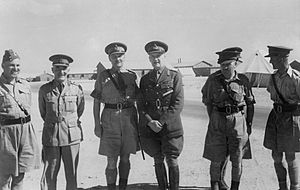
Hargest, now a brigadier, left New Zealand in May 1940. His brigade was the largest group in the Second Echelon. They were supposed to go to Egypt. But because of the threat of a German invasion of England, they were sent to England instead. The brigade trained and guarded areas around Dover. In early 1941, they finally shipped to Egypt.
Battles in Greece and Crete
Soon after, Hargest's brigade, part of the 2nd New Zealand Division, moved to Greece. They prepared for the German invasion. From 14 to 16 April, Hargest's brigade bravely defended their positions at Olympus Pass. They then had to retreat to help other New Zealand brigades withdraw. The brigade was evacuated to Crete on the night of 24 April.
Hargest and his brigade fought in the Battle of Crete in May. The 2nd New Zealand Division was led by Brigadier Edward Puttick. Freyberg was in charge of all Allied troops on Crete. Puttick gave Hargest's brigade the job of defending the Maleme airfield and its eastern approaches. The 22nd Battalion guarded the airfield and a nearby hill called Point 107. Hargest set up his headquarters some distance from the airfield.
German planes began bombing and strafing Allied positions. This was before an airborne invasion by German paratroopers. The bombing caused Hargest to feel confused and tired due to his past war experiences. When gliders with paratroopers landed on 20 May, the 22nd Battalion commander, Lieutenant Colonel Leslie Andrew, became cut off. He couldn't get clear information to Hargest. Andrew asked for reinforcements, but Hargest mistakenly said none were available. Andrew eventually had to withdraw his units. The Germans took the airfield and Point 107 early on 21 May. This allowed German reinforcements to land directly on Crete.
A counterattack was planned to retake the airfield. Hargest was very tired and pessimistic about its chances. The attack failed. Hargest, still far from the front lines, thought it was going well at first. His pessimism began to affect Puttick. The 5th Infantry Brigade eventually withdrew. The Allies began to retreat and evacuate from Crete on 31 May. Hargest flew to Egypt by seaplane.
Back in Egypt, Hargest criticised Freyberg's leadership in Crete. He also spoke to the New Zealand Prime Minister, Peter Fraser. Hargest later resolved his differences with Freyberg. Hargest's own actions on Crete were not officially criticised. He received another bar to his DSO. He also received the Greek War Cross for his service in Greece and Crete.
North Africa and Capture
After losing Crete, the 2nd New Zealand Division trained and re-equipped. They then joined the British Eighth Army in the North African Campaign. They took part in Operation Crusader in November 1941. The Eighth Army tried to reach Tobruk. Hargest's brigade covered the movements of other brigades.
Meanwhile, German tanks led by Generalleutnant Erwin Rommel outflanked the Allies. They approached Hargest's position. His headquarters was overrun by German tanks on 27 November 1941. Hargest and 700 of his men were captured. He was taken to Rommel. Rommel was impressed by the fighting spirit of the New Zealanders.
Prisoner of War and Escape
Hargest was sent to Italy. He was first held in a villa. Later, he was moved to Castle Vincigliata, called Campo 12, near Florence. This camp was for high-ranking officers. The prisoners had more comfortable conditions. In March 1943, Hargest and five other officers escaped. They used a tunnel dug from an old chapel inside the castle. Hargest and another New Zealander, Brigadier Reginald Miles, were the only two to reach safety in neutral Switzerland. They then tried to get to England separately.
Hargest later said, "I was over in Lucerne when Miles rang up to say he was off, and to suggest I should follow him later." With help from the French Resistance, Hargest traveled through France to Spain. He reached the British Consulate in Barcelona. He flew to England in December 1943.
Hargest was one of only three men known to British Military Intelligence to escape from an Italian prisoner of war camp and reach another country before Italy surrendered. For his escape, Hargest received a second bar to his DSO. He was also made a Commander of the Order of the British Empire. He even wrote a book about his escape called Farewell Campo 12.
Death and Lasting Memory
By early 1944, the 2nd New Zealand Division was fighting in Italy. Hargest sought a new role. He became New Zealand's observer for the D-Day landings in Normandy. He landed in Normandy on 6 June with the British 50th Infantry Division. He was wounded later that month.
After D-Day, Hargest was given a new job. He was to command a group helping New Zealand prisoners of war return home. But on 12 August 1944, he was killed by shell fire. This happened during the Battle of Normandy. He was making a farewell visit to the British 50th Division. Hargest is buried at the Hottot-les-Bagues War Cemetery in France.
Hargest had a wife and three children. His son, Geoffrey Hargest, was killed on 30 March 1944. He was 22 years old and serving with the 23rd Battalion during the Battle of Monte Cassino. He is buried in the Cassino War Cemetery. Another son was killed while serving during the Malayan Emergency. James Hargest High School, a school in Invercargill, is named after him.
Images for kids


